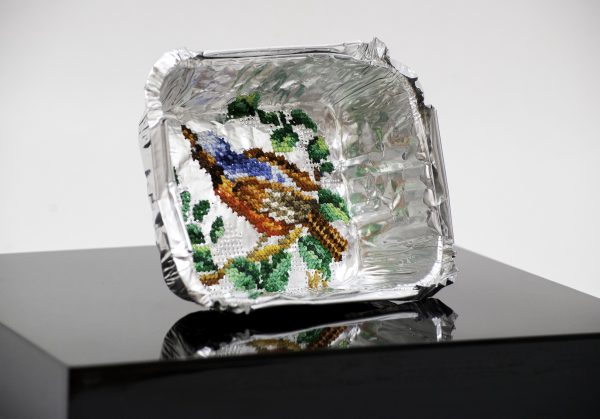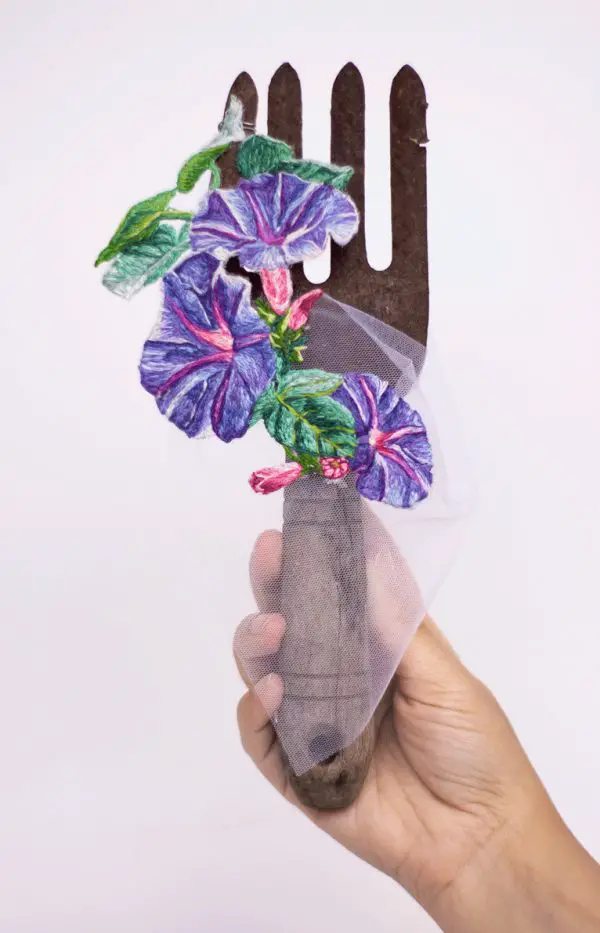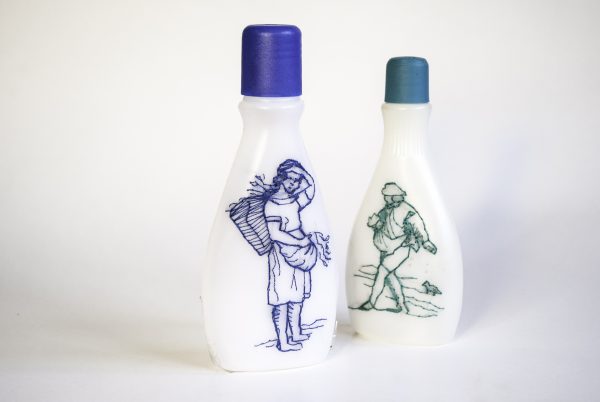
Today I am interviewing contemporary textile artist Valeria Faundez who’s embroidery canvases are microwave food trays, domestic plastic bottles and kitchen utensils. Her still life exhibitions elevate everyday objects from mass consumerism to a sculptural platform, challenging traditional concepts of what is ‘ART’? Let us explore her beautiful collection of traditional embroidery set against a backdrop of disposable product.
What motivated you to use domestic products as your embroidery ‘cloth’?
I began experimenting with embroidery and exploring how it could change the appearance of everyday objects which go unnoticed, transforming their value and meaning. I use domestic products because they are always present but most of the time invisible, unworthy, relegated to an existence that is just productive, utilitarian or even disposable. So, my main motivation comes from a question: What are the limits in making everything around us more beautiful?

Are products recycled? Describe the cleaning process ensuring materials are sanitized and will not degrade embroidery threads.
Not every product is recycled, for example kitchen tools and paper plates are bought new. Shampoo and detergent bottles, plastic and metallic trays, are recycled from home. I use alcohol as a cleaning solution, and also during the embroidery process to remove marks from handling. Every time I start a new piece I observe how the thread reacts to the material but I have never worked on a surface that could damage it. I think the worst enemy is sunlight, which can fade colour, so I keep every piece framed and exhibit away from direct light.


Do you use standard embroidery threads and do you reduce the ‘skeins’ (individual threads) for small detailed designs.
Yes, I use Mouliné thread most of the time, so I am able to vary the number of threads depending on the format I’m working on and detail of the design. For example, on paper, I used just 1 or 2 threads to create embroidered portraits (the “For Once” series), with a very narrow needle. I generally use 3 or 4 threads for cross stitch on plastic and metal trays. The needle has to pass through easily without breaking the object. Every size delivers a unique result.


Describe the technique of embroidering into 3D plastic bottles.
I think about their properties and characteristics. Can you see through them? Do they have a plain surface or colour? How hard is the material? I split the bottle so I can work on one side. I draw my design onto transparent paper and stick it to the surface of the bottle. Through the paper I outline the design with a series of holes, by hand or using a bradawl or dremel tool. According to the size and division between the holes, I choose the number of embroidery threads I will use. When embroidery is complete I piece the bottle back together again.

Which is your favourite ‘material’ and how different is the process of stitching compared to traditional embroidery fabric?
I really LOVE working with fabric because it is so much easier to construct the image, layering stitches and making corrections along the way. On other surfaces you have to be most precise about every stitch (eg. the eyes in the portrait made on paper). Every point must be well placed, carefully selecting colours in advance. There is less freedom in the needlework but results are more surprising. My favorite is recycled plastic or metal trays because they are more challenging to work with but are transformed through embroidery, making them more special.

Would you consider exploring other ‘objects’ and using recycled materials such as plastic and metal to embroider with?
The objects and materials I work with are disposable items created from mass serial production which is in contrast to the slow and unique intervention made in thread. Right now I’m working with old garden tools but not embroidering into the object itself. Embroidery is created and placed over the tool, playing with the silhouette.

Your ‘objects’ determine scale. Did this limit your design options? Are images transferred onto the object? Explain the process?
My workspace is pretty small so I work with small to medium sized objects, gathering them together, playing around with colour and form, to present as a unique composition for public installations. I source individual images from the internet, my own stock of photos, old books, illustrations, nature, patterns in old craft magazines, antique fabrics and tapestries. I use a collage process of printing and cutting images, blending in a very playful way. Images are stuck on, designs transferred in a series of holes to be embroidered.

Are you rejecting the traditional domestic role of women by using cleaning products and cooking implements in your work, or are you celebrating women?
I have to say for sure, it’s the second option: celebration, or visualization. I think this question has to take into account my background. I was born and still live in Chile, one of the most unequal countries in the world with women fighting for equal rights in all aspects of society. Domestic duties of house and children are culturally the responsibility of women, a job which is invisible and unpaid. This is what motivates me, to use these implements, take them from hidden drawers to exhibit with pride and recognition.

By elevating mass produced products to the status of ‘art’ are you rejecting and diminishing the traditional values / concepts of what ‘art’ is?
I have a profound affection to work with non sophisticated objects. The gesture of making them worthy is what motivates me. I did not consciously reject formal Art values. My work has humor and irony. It is a reflection of my place in the world. Coming from a non-developed country I feel like an outsider in the art world. I am trying to be heard, expressing my reality, using what I have around me, those little insignificant things, converting them to ‘Art’. Maybe someone will see them the same way I do.

Which artists do you admire and did any of them inspire you to explore the consumerism/ mass production element in your work?
The first artist who inspired me was Wim Delvoye, with his super over the top ornamental works, using traditional techniques of gothic metallic architecture and antique tapestry to construct fabulous objects with amazing detail. Another is Louise Saxton, creating beautiful textiles from recycled materials and embroidery. The last book I read by Byung Chul-Han, “The disappearance of rituals”, really got me inspired into working with mass produced materials, questioning consumerism and its consequences.
For more fabulous creations visit Valeria Faúndez – VISUAL ARTIST (valeriafaundez.cl) and Valeria Faúndez Balogi (@valeriabalogi) • Instagram photos and videos



